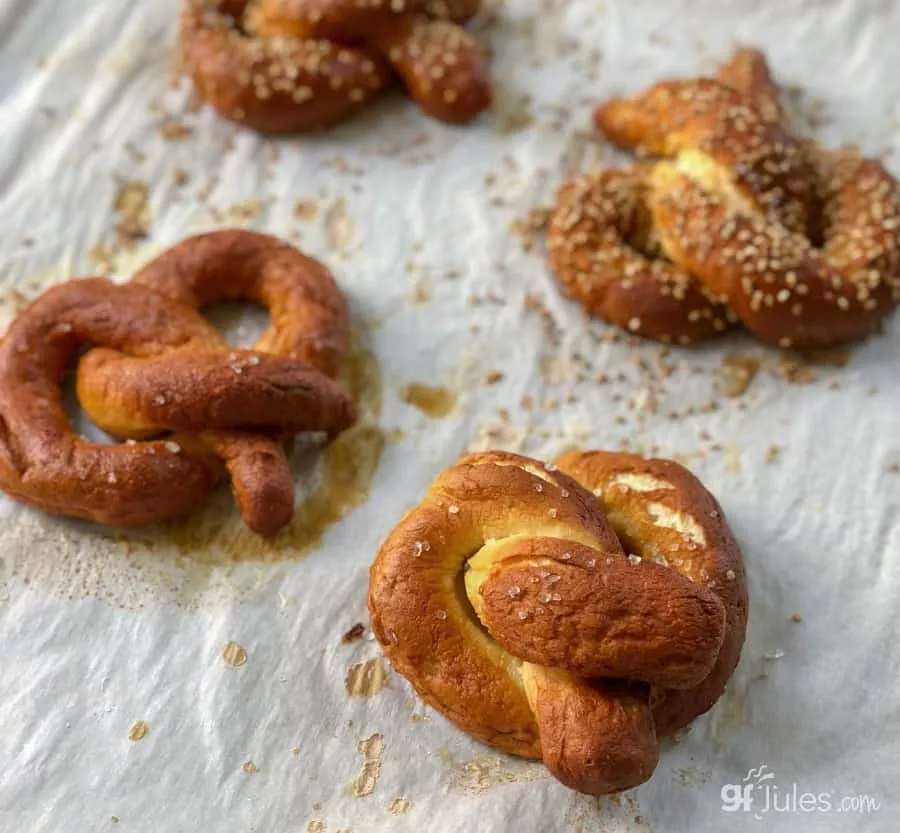
Ingredients
- 1 1/3 cups + 2 Tbs. (197 grams) gfJules™ Gluten Free All-Purpose Flour
- 1/2 tsp. salt
- 1/2 package (1 1/8 tsp.) rapid rise/bread machine yeast, gluten-free (Red Star®)
- 1 tsp. granulated cane sugar
- 8 Tbs. warm water (110° F)
- 1 Tbs. honey or agave nectar
- 1 egg room temperature (or egg substitute like 1 Tbs. flaxseed meal steeped in 3 Tbs. warm water)
- (1/2 cup baking soda for soda bath)
- oil butter or non-dairy alternative for brushing on top of pretzels (Earth Balance® Buttery Spread)
- coarse sea salt sesame seeds, or other toppings of choice
Instructions
- In a small bowl, mix warm water, sugar and yeast and let stand for 5 minutes. Measure and whisk together the gfJules Flour and salt set aside.
- In a large bowl, whisk the egg and honey. Stir in half of the proofed yeast mixture, then add half the flour mixture to the bowl. Beat on low speed, then add remaining flour mixture and yeast mixture, beating again to integrate the ingredients, then add one minute of mixing.
- The dough should be tacky, not wet or difficult to pull apart. If it is very wet, add more gfJules Flour by the tablespoon; if it is difficult to separate the dough into 4 balls because the dough is tough or tight, add warm water by the tablespoon to the dough, mixing until integrated and the dough is looser.
- You want it to be able to roll the dough out like soft playdough, but it should not be too wet that it's difficult to roll.
- Divide the dough into 4 equal sized balls. Gently roll small fistfuls of dough to approximately 1/2 inch diameter thick logs (use a very light dusting of gfJules™ All Purpose Flour to dust the rolling surface only if needed to keep the dough from sticking). If the dough is too coated in flour, it will be difficult to roll it out because there will be no friction, so dampen your mat or rolling surface.
- Take both ends of each log and twist into the middle.
- Press together to form a pretzel shape. Gently dab water under each of the ends of the twist to help them stick together, or they may release during the boil.
- Lay each pretzel onto a parchment-paper lined baking sheet.
- Use a pastry brush to dust off any excess flour, then liberally brush or spray the pretzel dough with water to keep it from drying out while rising. Cover with another sheet of oiled parchment and set aside to proof for up to 15 minutes. You do not want the pretzels to rise too much or too fast, so if your kitchen is already warm (as in summer), there is no need to move the pretzels to an oven or hotter location.
- Prepare a soda bath by adding baking soda to 8-10 cups of water in a large pot and bring to a boil over high heat. Stir until the soda is completely dissolved.
- Preheat the oven to 375° (static) or 350° (convection).
- Once the soda bath has achieved a rolling boil, gently submerge pretzels individually into the bath for 30 seconds, flipping over after about 15 seconds.
- Remove with a slotted spoon or skimmer, drain and replace the pretzels onto the parchment-lined baking sheet.
- Brush the boiled pretzels with oil or melted butter and top with coarse sea salt or other toppings. Bake for 10 minutes, or until golden brown. The pretzels will get darker using a convection setting. Do not over-bake.
- Remove to cool slightly before serving plain or with your favorite mustard!
Notes
As with any soft pretzel, these are best served the same day they are made.
** Please keep in mind that nutrition information provided is per serving, which may vary. While we have taken care to provide you with the most accurate nutritional values possible, please note that this information may differ significantly depending on the exact ingredients and brands that you choose to use to make this recipe. Additionally, where options are given for ingredients, the resulting calculation may include all ingredient options instead of only one per line, skewing the totals significantly.